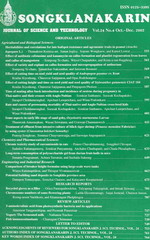ThaiScience
ThaiScience
SONGKLANAKARIN JOURNAL OF SCIENCE & TECHNOLOGY
Volume 42, No. 04, Month JULY, Year 2020, Pages 811 - 818
A mechanical behavior study of filament wound composite leaf springs
Abubakar Gambo Mohammed , Ercan Sevkat and Auwal Muhammad
Abstract Download PDF
The mechanical behavior of composite C- and O-shaped glass and carbon fiber epoxy leaf springs were investigated. The composite springs were manufactured via the filament winding method. The effects of design variables such as the spring thickness, fiber orientation, diameter, and clamping positions of the spring on the mechanical response were studied. Compression tests were conducted with a computer based control multi-purpose test suite machine. Test results revealed that Oshaped springs withstood a greater load compared to the C-shaped springs. Carbon fiber springs have much rigidity compared to the glass fiber springs. Increasing spring thickness positively affected the spring capacity. The springs with a smaller diameter exhibited a stiffer response compared to the others. Moreover, placing fibers close to 90º produced the highest spring load. Also, 95º clamping positions showed a better performance during the test. Finite element analysis was conducted using the Abaqus software package. Good agreement between experimental and numerical results was achieved.
Keywords
composite leaf spring, carbon fiber, glass fiber, finite element analysisSONGKLANAKARIN JOURNAL OF SCIENCE & TECHNOLOGY
Published by : Prince of Songkla University
Contributions welcome at : http://rdo.psu.ac.th
